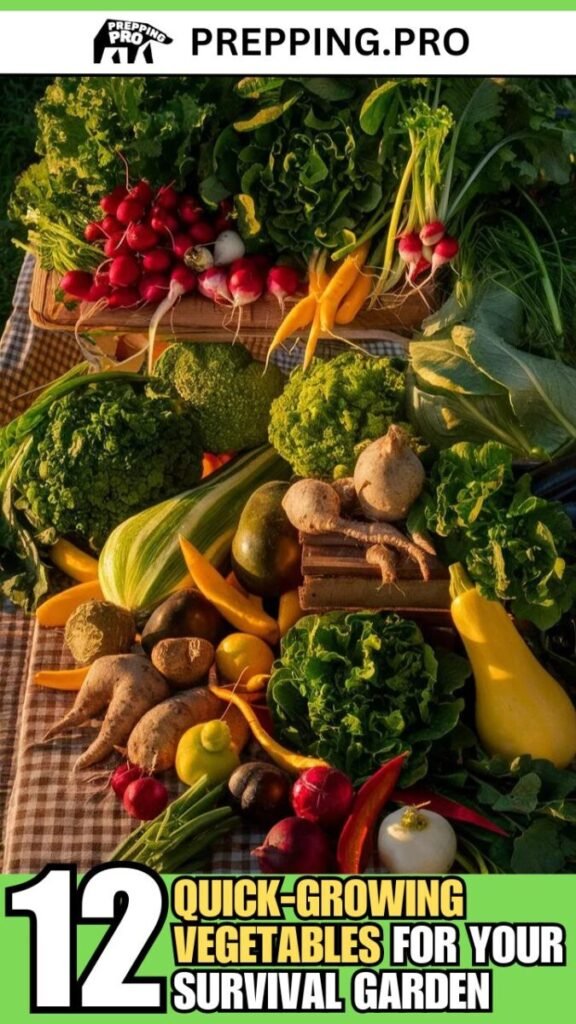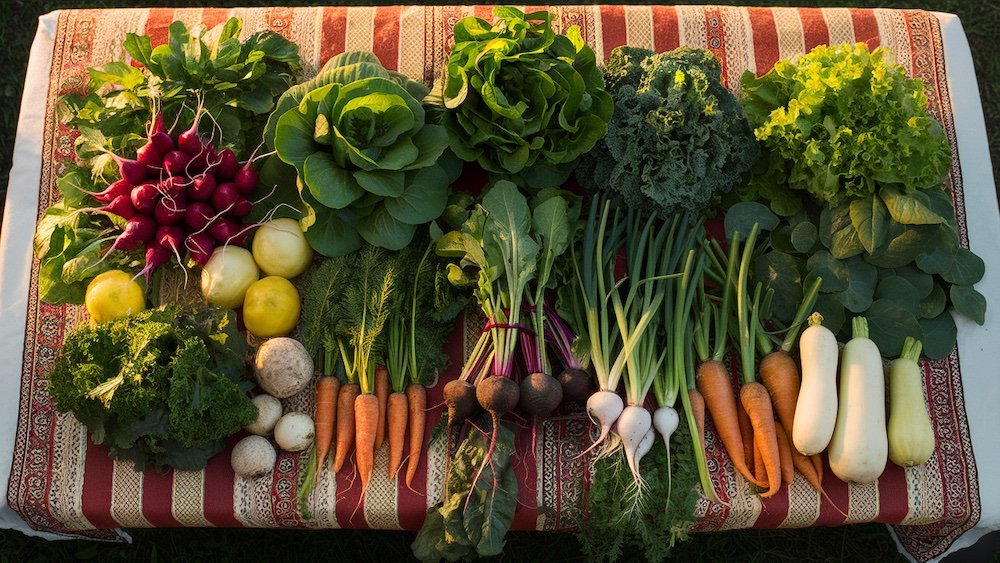In uncertain times, having a reliable source of fresh, nutritious produce is invaluable. That’s where a survival garden filled with quick-growing vegetables can make a world of difference.
Key Takeaways
- Learn about 12 fast-maturing veggies ideal for survival gardens
- Discover how to ensure a steady supply of fresh produce in as little as 30-60 days
- Get tips on growing, harvesting, and storing these nutrient-rich crops for year-round sustenance
Whether you’re a seasoned gardener or just starting, this comprehensive guide will equip you with the knowledge to cultivate a bountiful survival garden brimming with quick-growing vegetables that can be harvested in under two months.
Table of Contents
Leafy Greens

Leafy greens are nutrient-dense and fast-growing, providing essential vitamins and minerals. They are versatile and can be consumed raw or cooked.
Radishes
Radishes mature in just 25-30 days, making them one of the fastest-growing crops. They thrive in cool weather and can be grown in containers or raised beds. Harvest radishes when the shoulders protrude from the soil.
| Vegetable | Days to Maturity | Ideal Temperature | Planting Depth |
|---|---|---|---|
| Radishes | 25-30 days | 50-65°F | 1/2 inch |
- Sow seeds directly in the garden or containers every 2-3 weeks for a continuous harvest.
- Thin seedlings to 2 inches apart for proper root development.
- Harvest radishes when they reach desired size, typically 1-2 inches in diameter.
Lettuce
Lettuce is a cool-weather crop that can be harvested in as little as 30 days. It’s a versatile green that can be used in salads, sandwiches, and wraps.
| Vegetable | Days to Maturity | Ideal Temperature | Planting Depth |
|---|---|---|---|
| Lettuce | 30-45 days | 60-65°F | 1/4 inch |
- Sow seeds directly in the garden or containers every 2-3 weeks for a continuous harvest.
- Thin seedlings to 6-12 inches apart, depending on the variety.
- Harvest lettuce by cutting the leaves from the base or removing the entire head.
Spinach
Spinach is a nutrient-rich leafy green that can be harvested in as little as 40 days. It’s an excellent source of vitamins A, C, and K, as well as iron and calcium.
| Vegetable | Days to Maturity | Ideal Temperature | Planting Depth |
|---|---|---|---|
| Spinach | 40-50 days | 60-70°F | 1/2 inch |
- Sow seeds directly in the garden or containers every 2-3 weeks for a continuous harvest.
- Thin seedlings to 4-6 inches apart for proper growth.
- Harvest spinach by cutting the outer leaves, allowing the inner leaves to continue growing.
Arugula
Arugula is a fast-growing, peppery green that can be harvested in just 30-40 days. It’s a great addition to salads, sandwiches, and pizza.
| Vegetable | Days to Maturity | Ideal Temperature | Planting Depth |
|---|---|---|---|
| Arugula | 30-40 days | 55-65°F | 1/4 inch |
- Sow seeds directly in the garden or containers every 2-3 weeks for a continuous harvest.
- Thin seedlings to 4-6 inches apart for proper growth.
- Harvest arugula by cutting the leaves from the base or removing the entire plant.
Brassicas
Brassicas, also known as cruciferous vegetables, are nutrient-dense and versatile. They can be eaten raw or cooked and are excellent sources of vitamins and minerals.
Mustard Greens
Mustard greens are a fast-growing brassica that can be harvested in as little as 40 days. They have a slightly pungent flavor and are rich in vitamins A, C, and K.
| Vegetable | Days to Maturity | Ideal Temperature | Planting Depth |
|---|---|---|---|
| Mustard Greens | 40-50 days | 60-70°F | 1/4 inch |
- Sow seeds directly in the garden or containers every 2-3 weeks for a continuous harvest.
- Thin seedlings to 6-8 inches apart for proper growth.
- Harvest mustard greens by cutting the outer leaves, allowing the inner leaves to continue growing.
Kale
Kale is a nutrient-dense brassica that can be harvested in as little as 50 days. It’s an excellent source of vitamins A, C, and K, as well as calcium and iron.
| Vegetable | Days to Maturity | Ideal Temperature | Planting Depth |
|---|---|---|---|
| Kale | 50-60 days | 60-70°F | 1/4 inch |
- Sow seeds directly in the garden or containers every 2-3 weeks for a continuous harvest.
- Thin seedlings to 12-18 inches apart for proper growth.
- Harvest kale by cutting the outer leaves, allowing the inner leaves to continue growing.
Root Vegetables
Root vegetables are a great source of carbohydrates, fiber, and essential nutrients. They can be eaten raw, cooked, or preserved for later use.
Beets
Beets are a fast-growing root vegetable that can be harvested in as little as 50 days. They are rich in vitamins A and C, as well as folate and manganese.
| Vegetable | Days to Maturity | Ideal Temperature | Planting Depth |
|---|---|---|---|
| Beets | 50-60 days | 60-70°F | 1/2 inch |
- Sow seeds directly in the garden or containers every 2-3 weeks for a continuous harvest.
- Thin seedlings to 3-4 inches apart for proper root development.
- Harvest beets when the shoulders protrude from the soil or when the greens reach 6-8 inches tall.
Carrots
Carrots are a versatile root vegetable that can be harvested in as little as 50 days. They are an excellent source of vitamin A and fiber.
| Vegetable | Days to Maturity | Ideal Temperature | Planting Depth |
|---|---|---|---|
| Carrots | 50-70 days | 60-70°F | 1/4 inch |
- Sow seeds directly in the garden or containers every 2-3 weeks for a continuous harvest.
- Thin seedlings to 2-3 inches apart for proper root development.
- Harvest carrots when the shoulders protrude from the soil or when the tops reach 6-8 inches tall.
Turnips
Turnips are a fast-growing root vegetable that can be harvested in as little as 40 days. Both the roots and greens are edible and nutritious.
| Vegetable | Days to Maturity | Ideal Temperature | Planting Depth |
|---|---|---|---|
| Turnips | 40-60 days | 60-70°F | 1/4 inch |
- Sow seeds directly in the garden or containers every 2-3 weeks for a continuous harvest.
- Thin seedlings to 4-6 inches apart for proper root development.
- Harvest turnips when the shoulders protrude from the soil or when the greens reach 6-8 inches tall.
Green Onions
Green onions, also known as scallions or spring onions, are a fast-growing allium that can be harvested in as little as 30 days. They add flavor and nutrients to various dishes.
| Vegetable | Days to Maturity | Ideal Temperature | Planting Depth |
|---|---|---|---|
| Green Onions | 30-40 days | 60-70°F | 1/4 inch |
- Sow seeds directly in the garden or containers every 2-3 weeks for a continuous harvest.
- Thin seedlings to 2-4 inches apart for proper growth.
- Harvest green onions by cutting the green tops, leaving the white base to continue growing.
Legumes and Squash
Legumes and squash are versatile and nutritious additions to a survival garden. They provide protein, fiber, and essential vitamins and minerals.
Bush Beans
Bush beans are a fast-growing legume that can be harvested in as little as 50 days. They are an excellent source of protein, fiber, and various vitamins and minerals.
| Vegetable | Days to Maturity | Ideal Temperature | Planting Depth |
|---|---|---|---|
| Bush Beans | 50-60 days | 65-80°F | 1 inch |
- Sow seeds directly in the garden or containers after the last frost date.
- Space seeds 2-4 inches apart in rows 18-24 inches apart.
- Harvest bush beans when the pods are firm and the seeds are well-formed but still tender.
- Pick regularly to encourage continued production.
For more information on growing bush beans and other legumes, check out our detailed guide.
Summer Squash
Summer squash, such as zucchini and yellow squash, are fast-growing and prolific producers that can be harvested in as little as 50 days. They are a good source of vitamins A and C, as well as fiber.
| Vegetable | Days to Maturity | Ideal Temperature | Planting Depth |
|---|---|---|---|
| Summer Squash | 50-60 days | 65-80°F | 1 inch |
- Sow seeds directly in the garden or containers after the last frost date.
- Space seeds 12-18 inches apart in rows 3-4 feet apart.
- Harvest summer squash when they are 6-8 inches long and the skin is still tender.
- Pick regularly to encourage continued production.
Summer squash is an excellent choice for small-space gardening, as it can be grown vertically or in containers.
Growing Tips

To ensure a successful survival garden, follow these growing tips:
- Succession planting: Stagger plantings every 2-3 weeks to ensure a continuous harvest.
- Companion planting: Grow complementary crops together to deter pests, improve soil health, and maximize space. For example, planting marigolds can help repel nematodes and other pests.
- Soil preparation: Amend the soil with compost or aged manure to provide essential nutrients for optimal growth.
- Fertilization: Apply a balanced organic fertilizer every 4-6 weeks to replenish nutrients in the soil.
Storing and Preserving
Proper storage and preservation techniques are essential to extend the shelf life of your harvest and ensure a year-round supply of fresh produce.
- Refrigeration: Store leafy greens, root vegetables, and summer squash in the refrigerator for up to 1-2 weeks.
- Canning: Preserve vegetables by canning them in sterilized jars for long-term storage. Check out our guide on canning and preserving techniques.
- Freezing: Blanch and freeze vegetables for later use.
- Dehydrating: Dry vegetables to create lightweight and shelf-stable products.
Conclusion
Incorporating quick-growing vegetables into your survival garden is crucial for ensuring a steady supply of fresh, nutritious produce. The 12 vegetables covered in this article – radishes, lettuce, spinach, arugula, mustard greens, kale, beets, carrots, turnips, green onions, bush beans, and summer squash – can all be harvested in 60 days or less.
Having a diverse survival garden not only provides food security but also promotes self-sufficiency and resilience in challenging times. Start growing your own food today and enjoy the benefits of fresh, homegrown produce right from your backyard. For more tips on essential survival crops and urban gardening techniques, check out our other articles.


